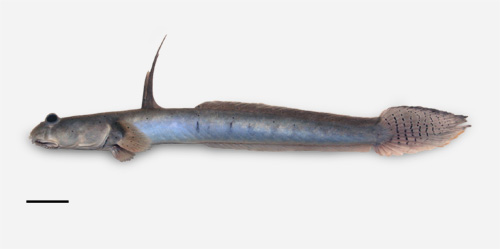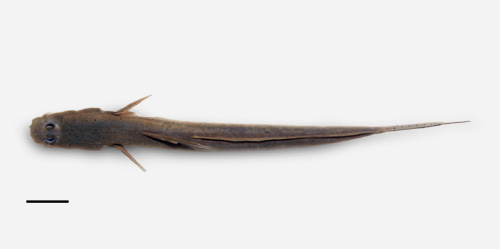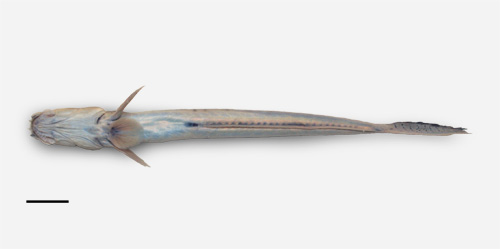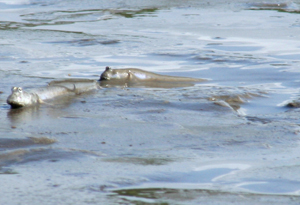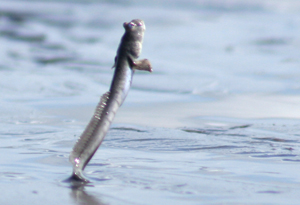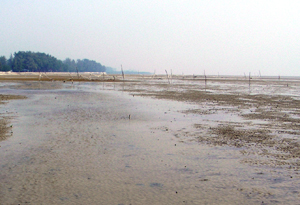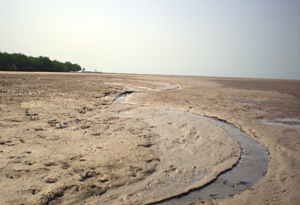Common names:
Australia |
English |
blue mud-hopper |
Bangladesh |
Bengali |
dahuk |
China |
Chinese Mandarin |
青弹涂鱼, 青彈塗魚 (qing tan tu yu - green mudskipper) |
Finland |
Finnish |
viherviiriryömijä |
Japan |
Japanese |
tokagehaze |
Hong Kong |
English |
walking goby |
Hong Kong |
Cantonese |
花跳 (fa tiu - fasciate goby - used for any mudskipper with similar colouration pattern) |
Italy |
Italian |
saltafango barbuto* |
Malaysia |
Bahasa Malaysia |
ikan belacak binte biru |
Papua New Guinea |
English |
bearded goby |
Taiwan |
Chinese Mandarin |
青彈塗魚 (cing tan tu yu) |
Viet Nam |
English |
walking goby |
Viet Nam |
Vietnamese |
cá thòi lòi chấm |
* proposed name
|
|
|
Synonyms:
Gobius viridis |
Hamilton, 1822 |
(primary homonym of G. viridis Otto, 1821, not replaced, invalid) |
Scartelaos viridis |
(Hamilton, 1822) |
(new combination) |
Boleophthalmus viridis |
(Hamilton, 1822) |
(new combination) |
Boleophthalmus histophorus |
Valenciennes, 1837* |
(senior synonym) |
Scartelaos histophorus |
(Valenciennes, 1837*) |
(senior syn., new combination) |
Scartelaos histiophorus |
(Valenciennes, 1837*) |
(mispelling for histophorus) |
Boleophthalmus sinicus |
Valenciennes, 1837* |
(junior synonym) |
Boleophthalmus chinensis |
Valenciennes, 1837* |
(junior synonym) |
Boleophthalmus aucupatorius |
Richardson, 1845 |
(junior synonym) |
Boleophthalmus campylostomus |
Richardson, 1846 |
(junior synonym) |
Apocryptes macrophthalmus |
Castelnau, 1873 |
(junior synonym) |
Gobiosoma guttulatum |
Macleay, 1878 |
(junior synonym) |
Gobiosoma punctularum |
De Vis, 1884 |
(junior synonym) |
Boleophthalmus novaeguineae |
Hase, 1914 |
(junior synonym) |
Boleophthalmus novaeguinea |
Hase, 1914 |
(mispelling for novaeguineae) |
*In: Cuvier & Valenciennes, 1837
Etymology:
'Scartelaos' is probably a compound name from the Greek 'skarthmos' (leaping), and 'laos' (people, folk), which maybe refers to
the typical tail-stand of males during courtship
'histophorus' is another compound form, from the Greek 'hystos' (pole, mast), and 'phorein' (to bear, to wear), which refer to the narrow and pointed first dorsal fin (Cuvier & Valenciennes, 1837)
|
Maximum recorded length:
125 mm SL (Murdy, 1989)
140 mm SL (Rainboth, 1996)
Live colouration (Murdy, 1989; Polgar et al., 2010; Takita et al., 2011; pers. obs.: Australia, NT):
ground colour on dorsum and flanks greenish grey: dorsally darker; venter pale blue to whitish; cheek and trunk with scattered bluish to black speckles; 4-8
dark grey to bluish, narrow vertical bars frequently visible on flanks; D1 greenish grey; D2 dusky to greenish grey with tiny bluish spots; caudal fin
grey with 3-5 black wavy, broken lines, posterior margin black;
anal fin transparent; pectoral and pelvic fins dusky; males of Australian populations have white eye borders
(Townsend & Tibbets, 2005)
Colouration on preservation (Murdy, 1989; pers. obs.: Australia, Papua New Guinea, Peninsular Malaysia):
ground colour slate grey to brown, ventrally paler; dusky spots, bars and speckles frequently lacking
Diagnosis (Murdy, 1989):
head depth 10.1-12.4%SL; caudal fin length 18.5-25.1%SL; length of D1 base 5.7-7.5%SL; D2 and anal fins
connected by membrane to the caudal fin; barbel on tip of chin (ventral midline), near the symphysis of lower jaw;
narrow vertical dark bars on flanks; no large, black spots or stripes basally on posterior half of D2.
The genus is characterised by the presence of barbels on the ventral surface of the
head (see drawing)
Diet:
benthic feeder, omnivorous: it feeds on diatoms and small invertebrates (nematodes,
ostracods, copepods, etc.: Milward, 1974; Khoo 1966, cited in
Clayton, 1993)
|
|
| Reproduction:
its reproductive behaviour at low tide and out of the burrows has been described by
Milward (1974)
and Towsend & Tibbets (2005):
the males stand on their tails to attract females into their
burrows and spawn; other details of its life cycle have not been studied
(see also Reproductive behaviour)
left: a reproductive couple; the larger male is on the left; the burrow entrance is on the right
right: a tail stand by a male trying to attract a female from the distance
(photos: G. Polgar, Purutu Is., Fly river delta, Papua New Guinea)
|
|
|
|
Ecological notes (Polgar & Crosa, 2009; Polgar et al., 2010; Takita et al., 2011; pers. obs.: Australia NT):
during low tide, larger individuals are more abundant at lower levels on tidal flats, below the mean sea level, while smaller individuals are frequently found
at higher levels, in mangrove pneumatophore zones (Murdy, 1986;
Polgar et al., 2010),
and on creek banks (Milward, 1974). S. histophorus can be found in relatively variable environmental conditions during low tide, e.g. on mixed or mud tidal flats, and in areas with different density of tide pools and structural elements (plant debris, pneumatophores, etc.)
left: Morib, Peninsular Malaysia: mudflat; smaller S. histophorus are abundant
at higher levels, a few metres from the last row of trees, while larger individuals dig their burrows at lower levels on the
mixed tidal flat (photo: G. Polgar, 2006)
right: Ludmilla Creek, Darwin, NT, Australia; larger S. histophorus are here present nearby gullies discharging into the creek's mouth (photo: G. Polgar, 2007)
|
|
|
|
|
Distribution:
from Pakistan to Japan and Australia; type locality: Ganges Delta, India
(Murdy, 1989)
|
Remarks:
several authors reported marked and periodical fluctuations of the population size
(Milward, 1974;
Townsend & Tibbets, 1995)
|
Photographs of Scartelaos histophorus:
|
A, B: S. histophorus
feeding and interacting at low tide (photo: M. Takata, Okinawa, Japan,
2000);
C: close-up (photo: T. Mukai, Japan,
2006)*;
D: another close-up (photo: Y. Ikebe, Okinawa, Japan,
2002)*; E: "stand on tail" behaviour of a male during courtship (photo: G. Polgar, Purutu Is.,
Fly river delta, Papua New Guinea, 2007); F: juvenile of
S. histophorus in a plastic bag (photo: G. Polgar, Kuala Lumpur, 2006); G: close-up of a
juvenile in aquarium (photo: G. Polgar, Kuala Lumpur, 2006); H: juvenile in a tide pool at low tide,
Acanthus sp. zone on a high step behind a mudflat (photo: G. Polgar, Purutu Is., Papua New Guinea, 2007);
I: a specimen in aquarium (photo: G. Polgar; collected in Ludmilla Creek, Darwin, NT, Australia, 2007);
J: detail of the barbels: note the diagnostic one on tip of chin (photo: G. Polgar; collected in Ludmilla
Creek, Darwin, NT, Australia, 2007); K: expelling a bubble of air after air gulping (photo: G. Polgar,
Purutu Is., Fly river delta, Papua New Guinea, 2007); L: a couple of adults in aquarium: note the different
colour of the eyes' borders (photo: G. Polgar; collected in Ludmilla Creek, Darwin, NT, Australia, 2007)* with permission
|
Drawings of Scartelaos histophorus:
A: cephalic sensory and nasal pores of Scartelaos spp.: an = anterior nostril;
ao = anterior oculoscapular canal pore; pn = posterior nostril (modified from
Murdy, 1989)*; B: ventral view of the head of S. histophorus:
B = barbels (modified from Murdy, 1989)*;
C: Scartelaos viridis (Hamilton) (Herre, 1927);
D: Scartelaos histophorus (Valenciénnes) by Roger Swainston
(Allen, 1997)*; E: Scartelaos viridis (Hamilton)
(Koumans, 1953); F: Scartelaos viridis (Hamilton)
(Bleeker, 1983)*;
G: Gobius viridis Hamilton (Hamilton, 1822) - * with permission
|




